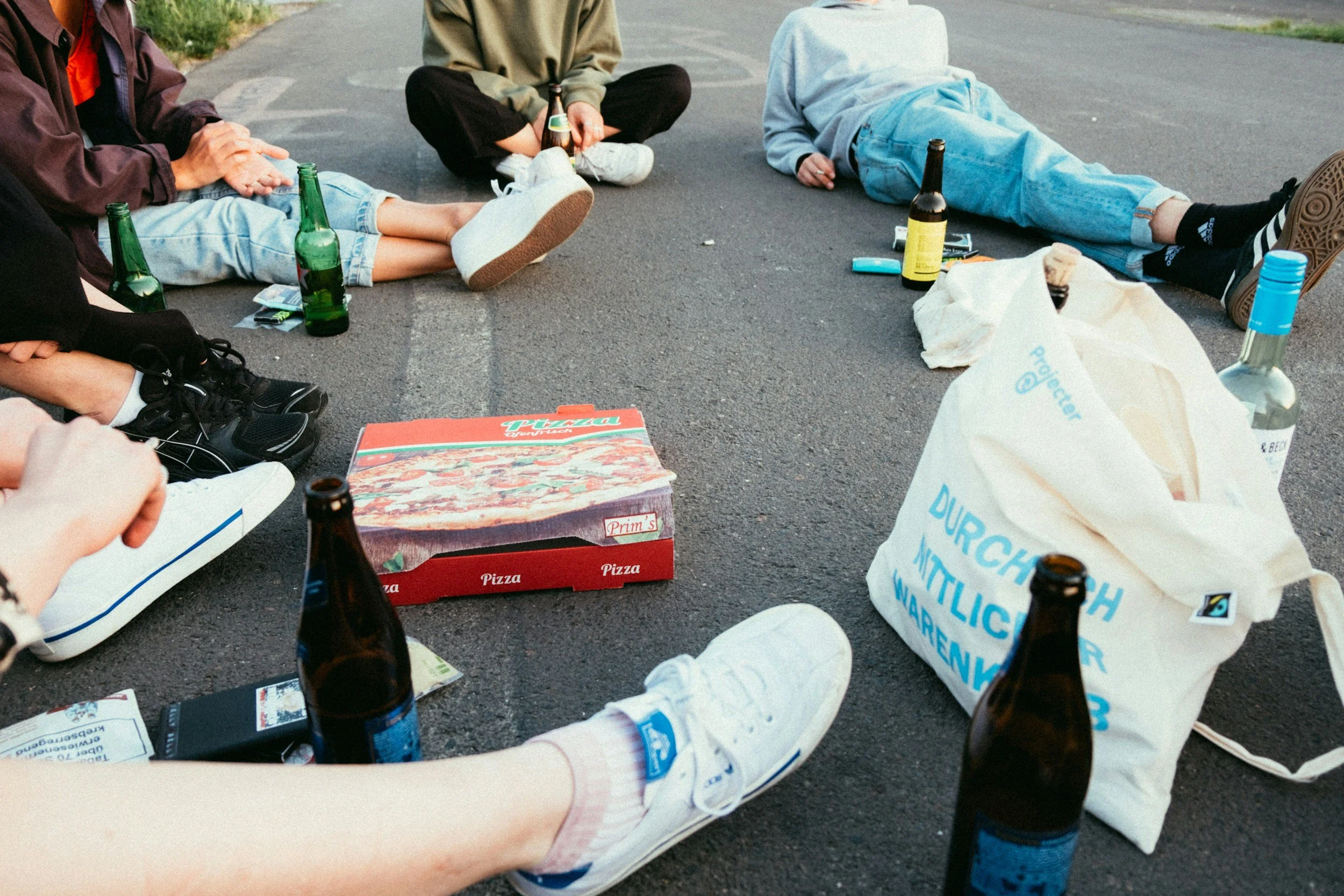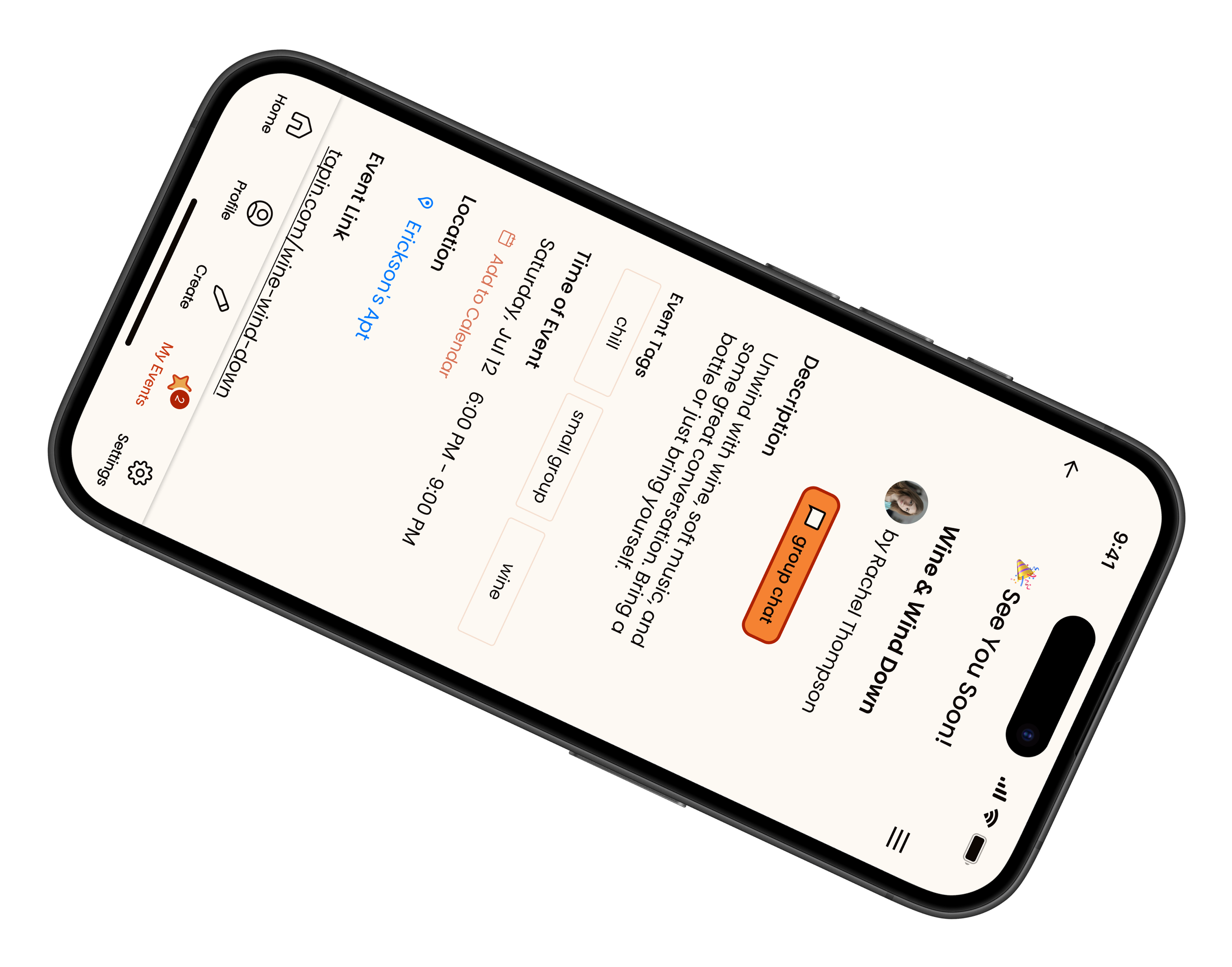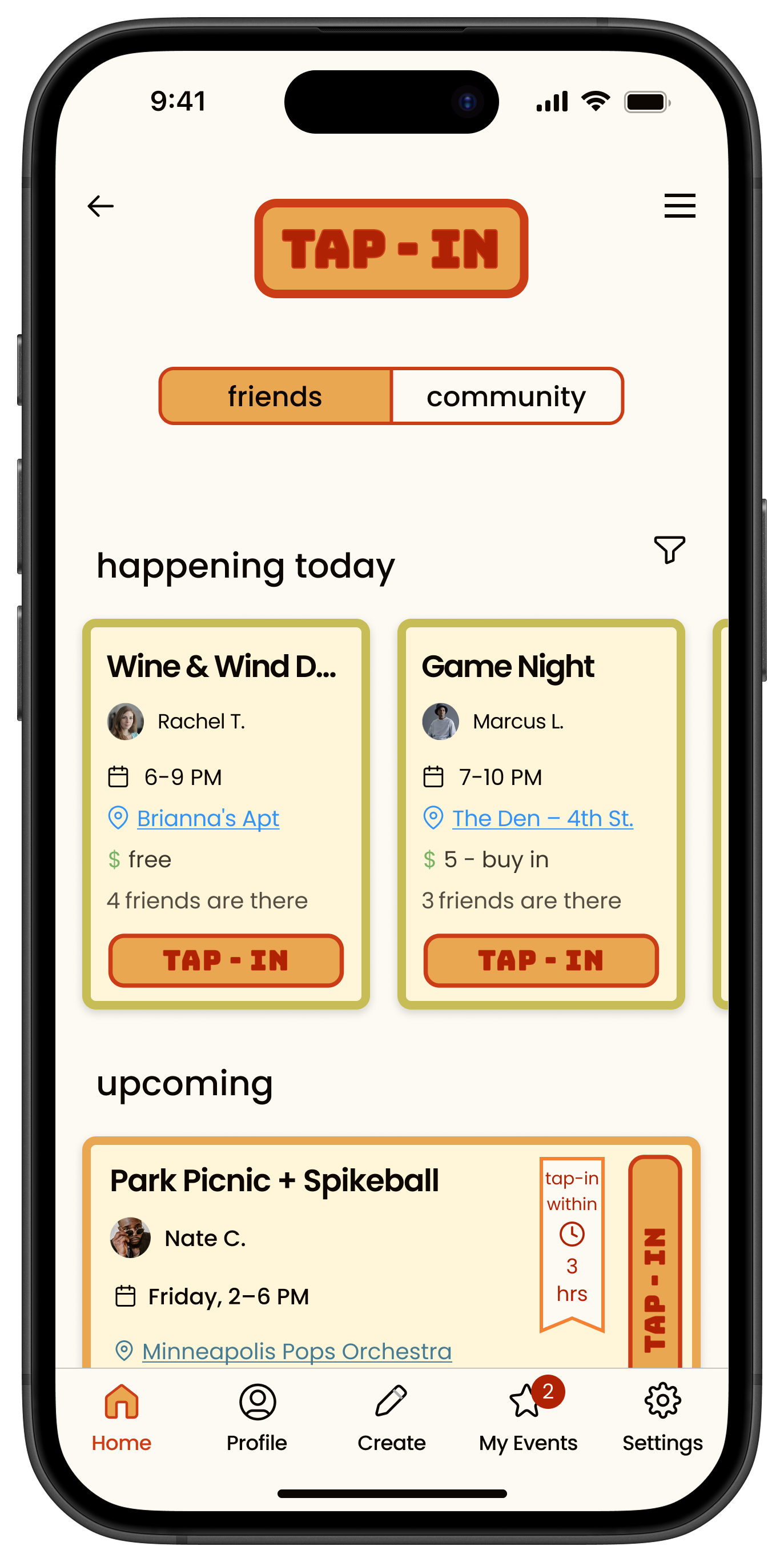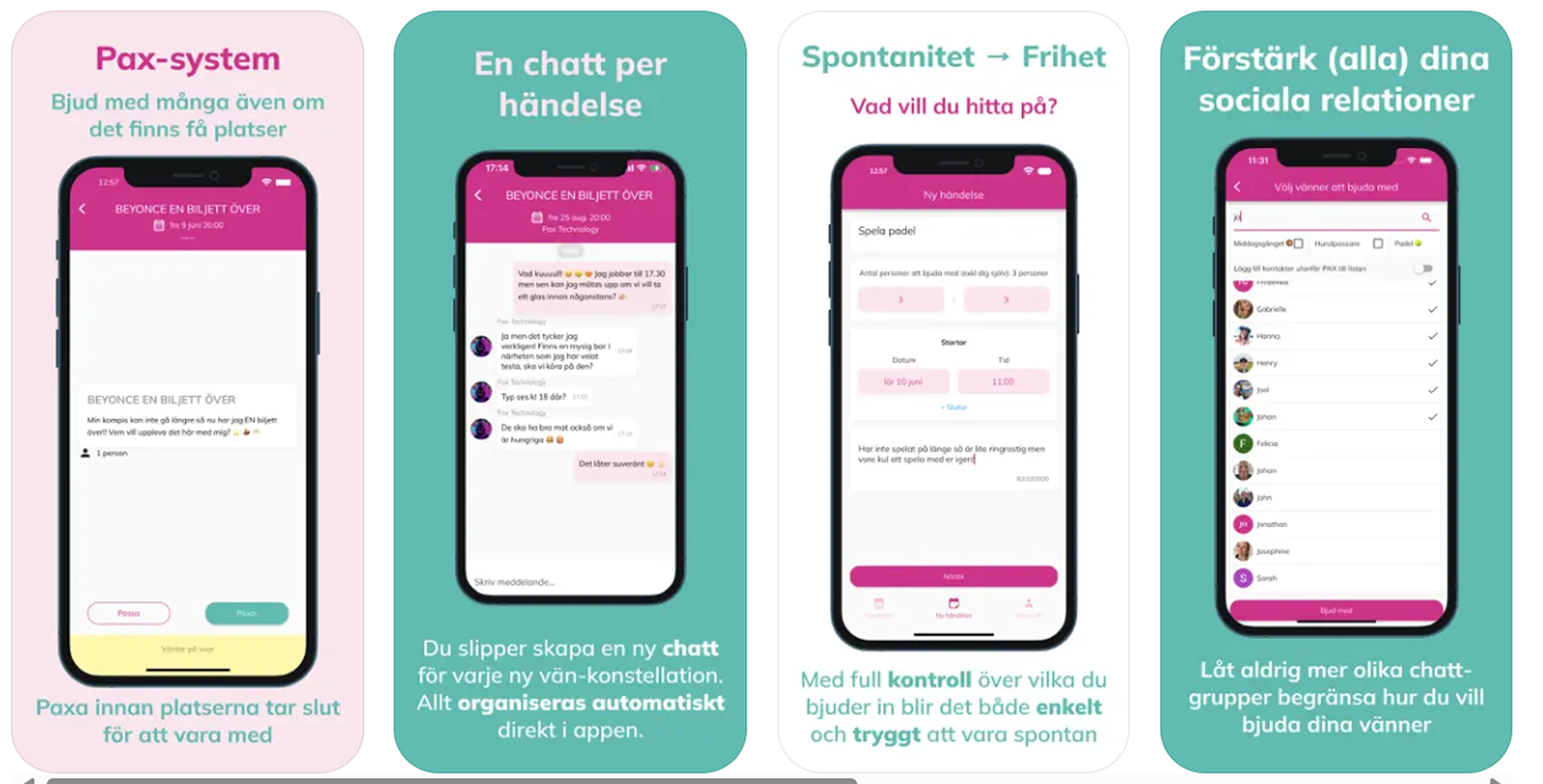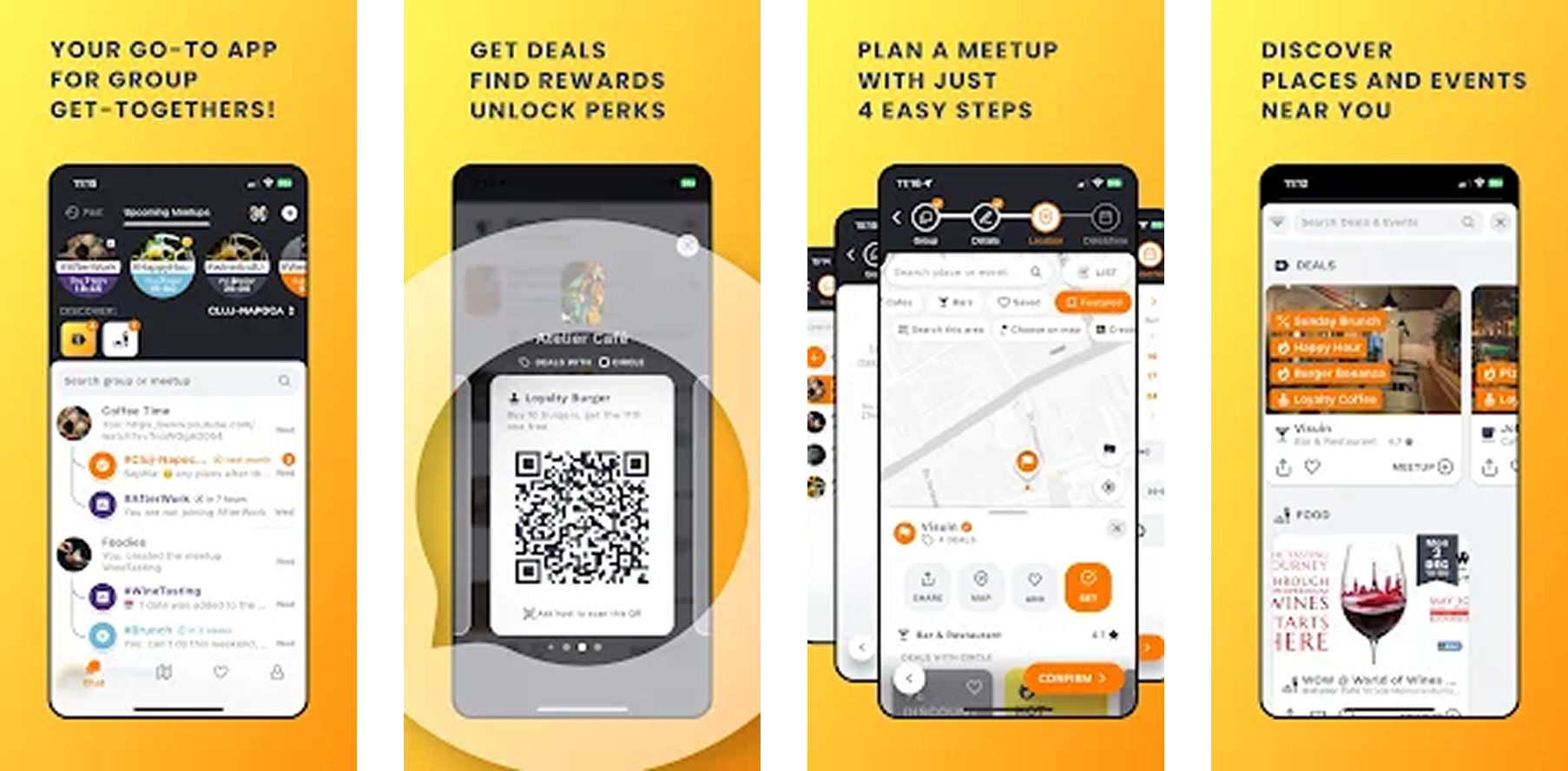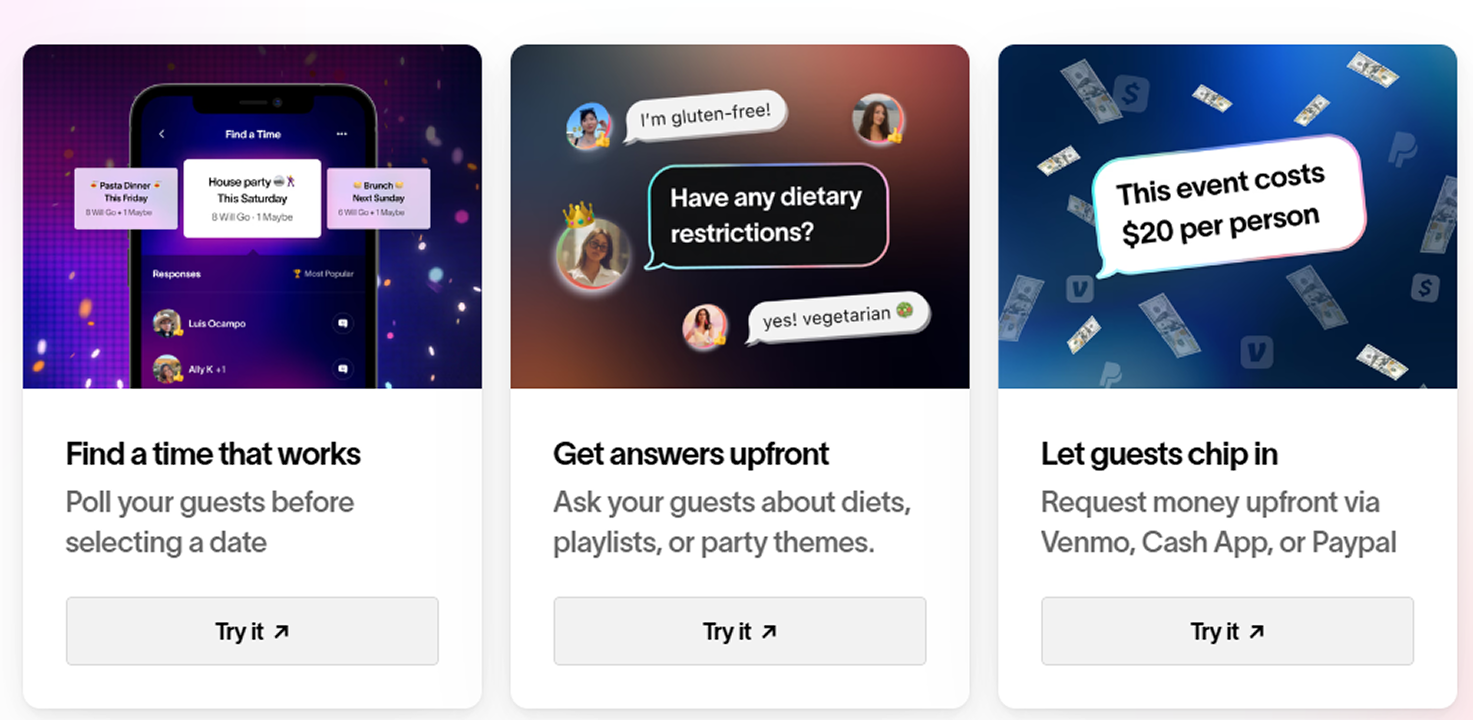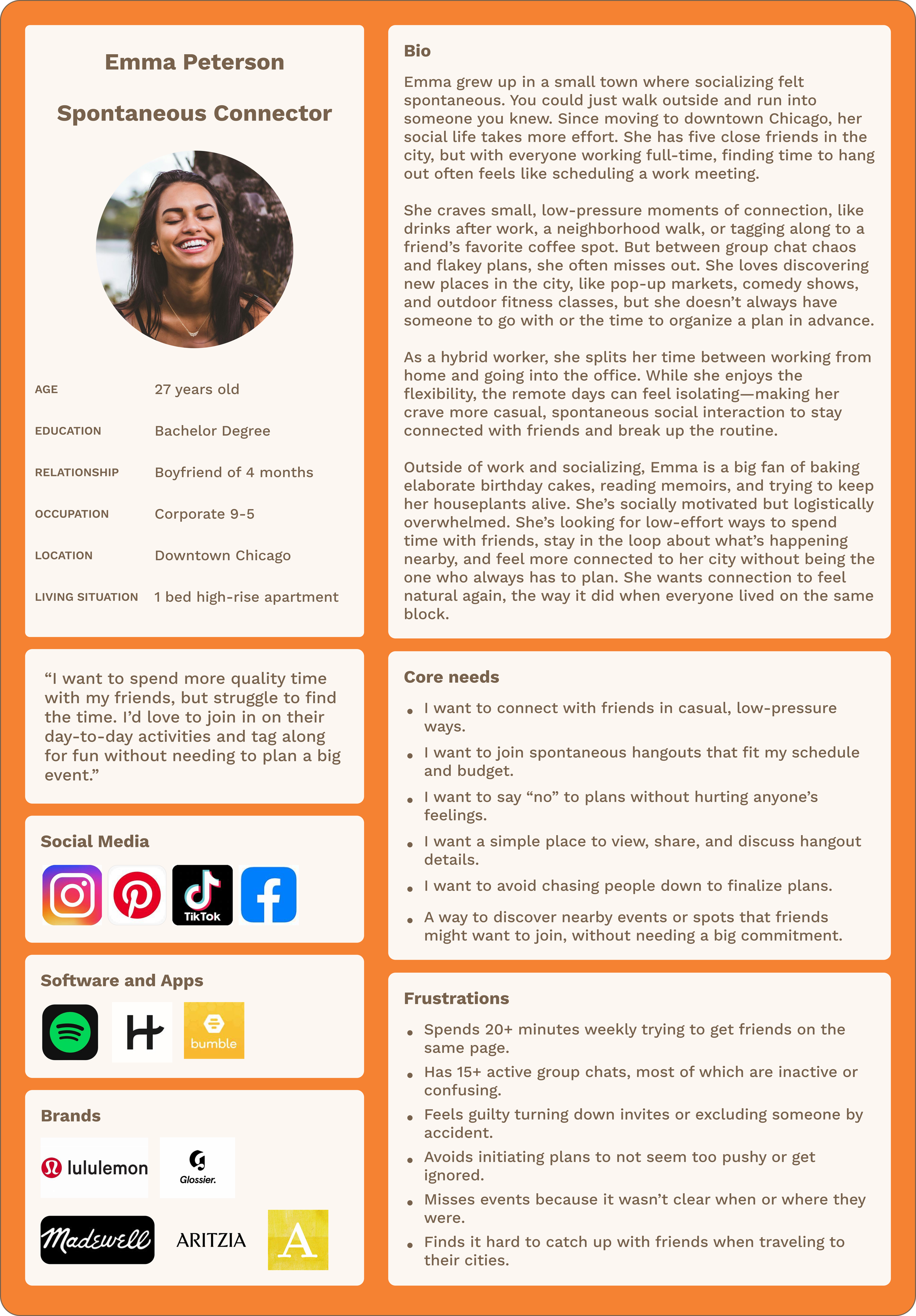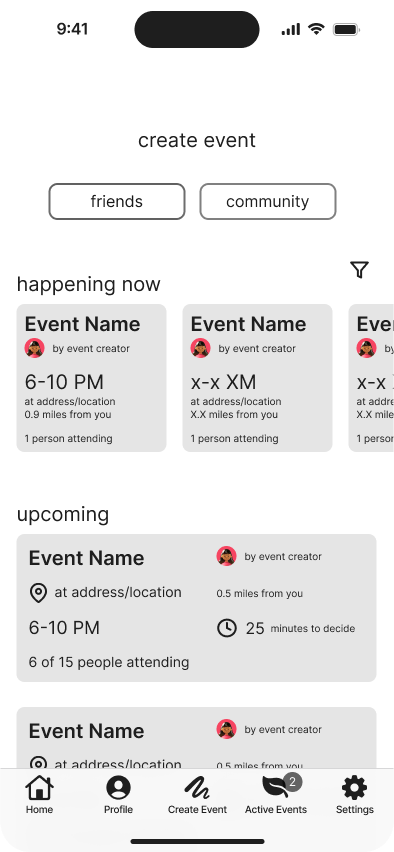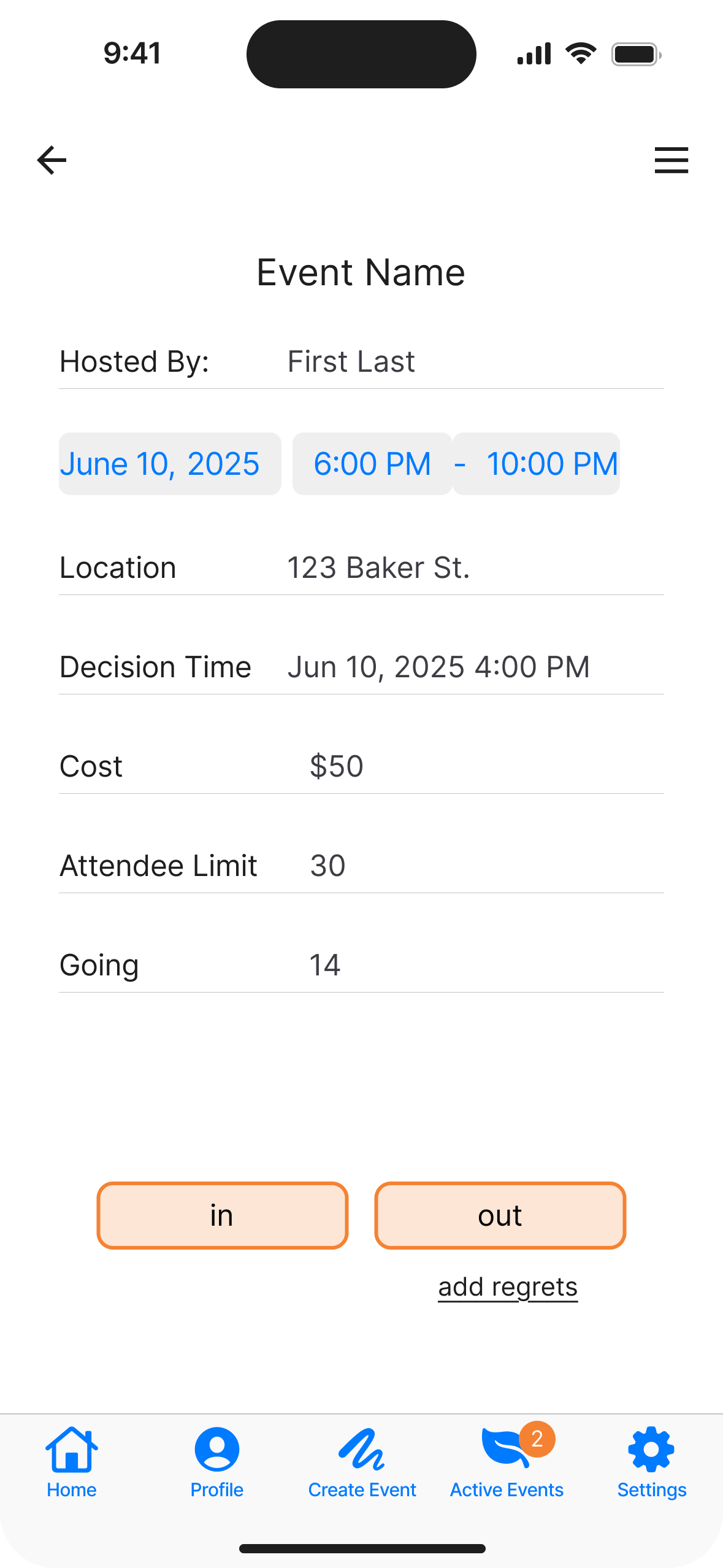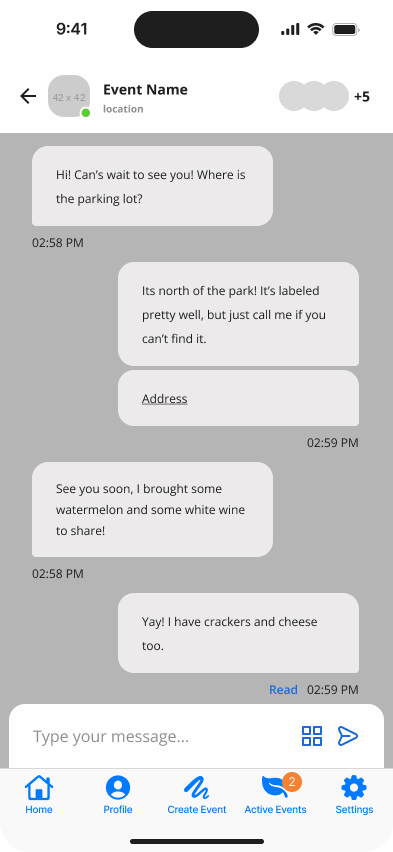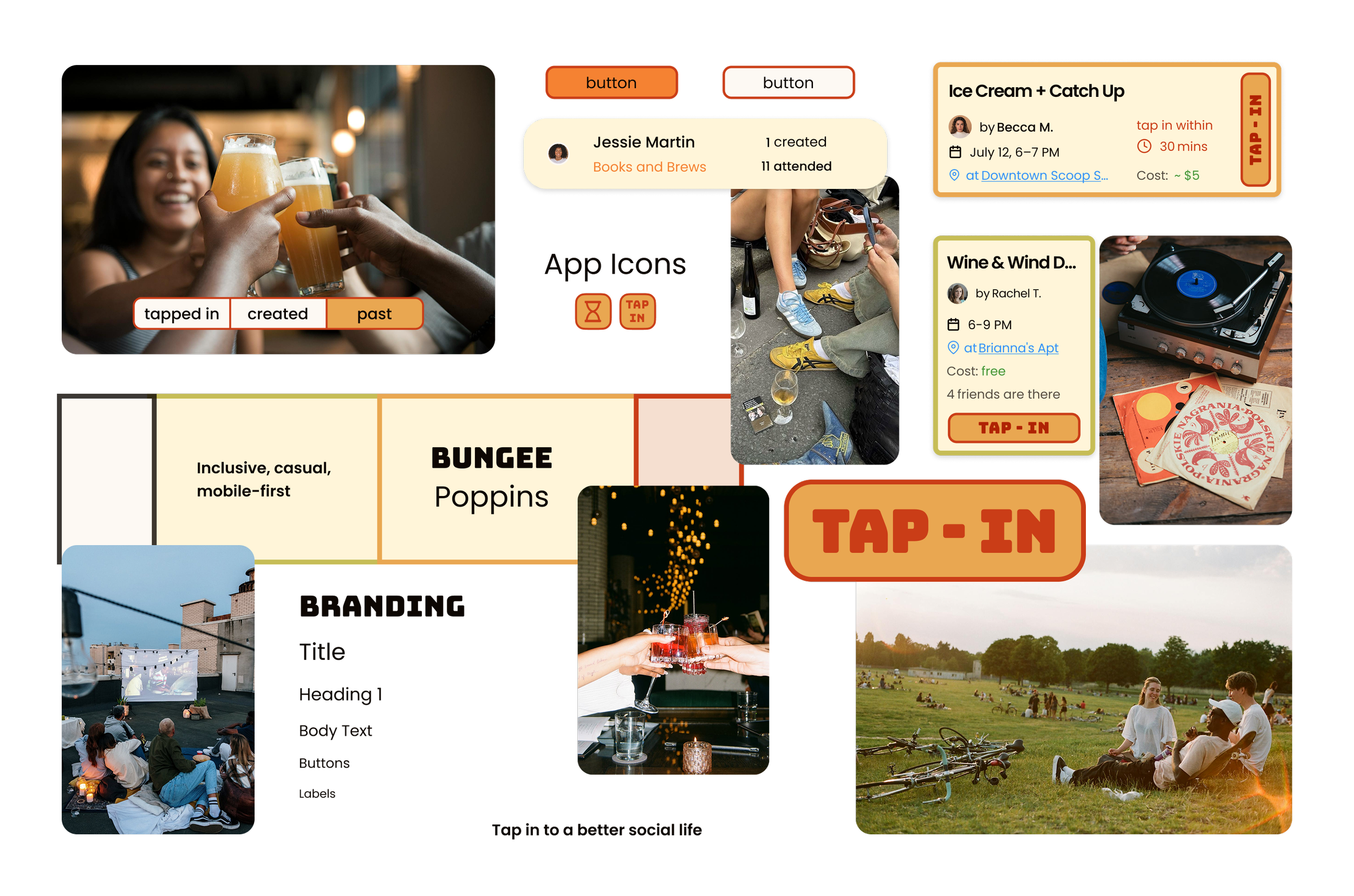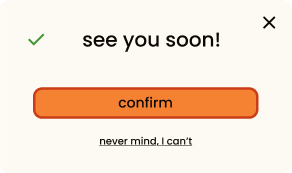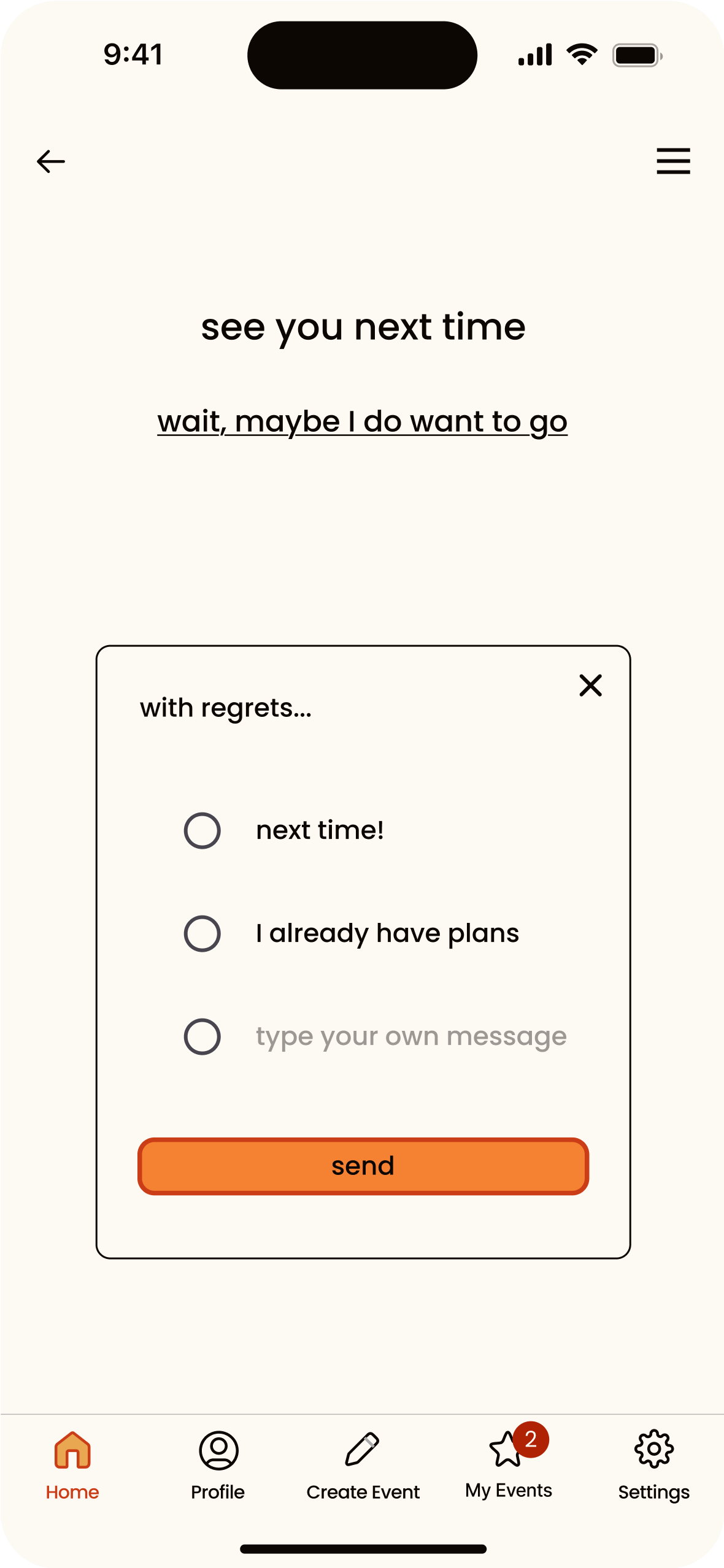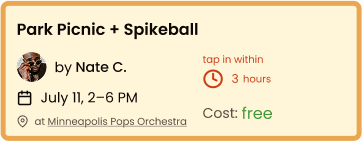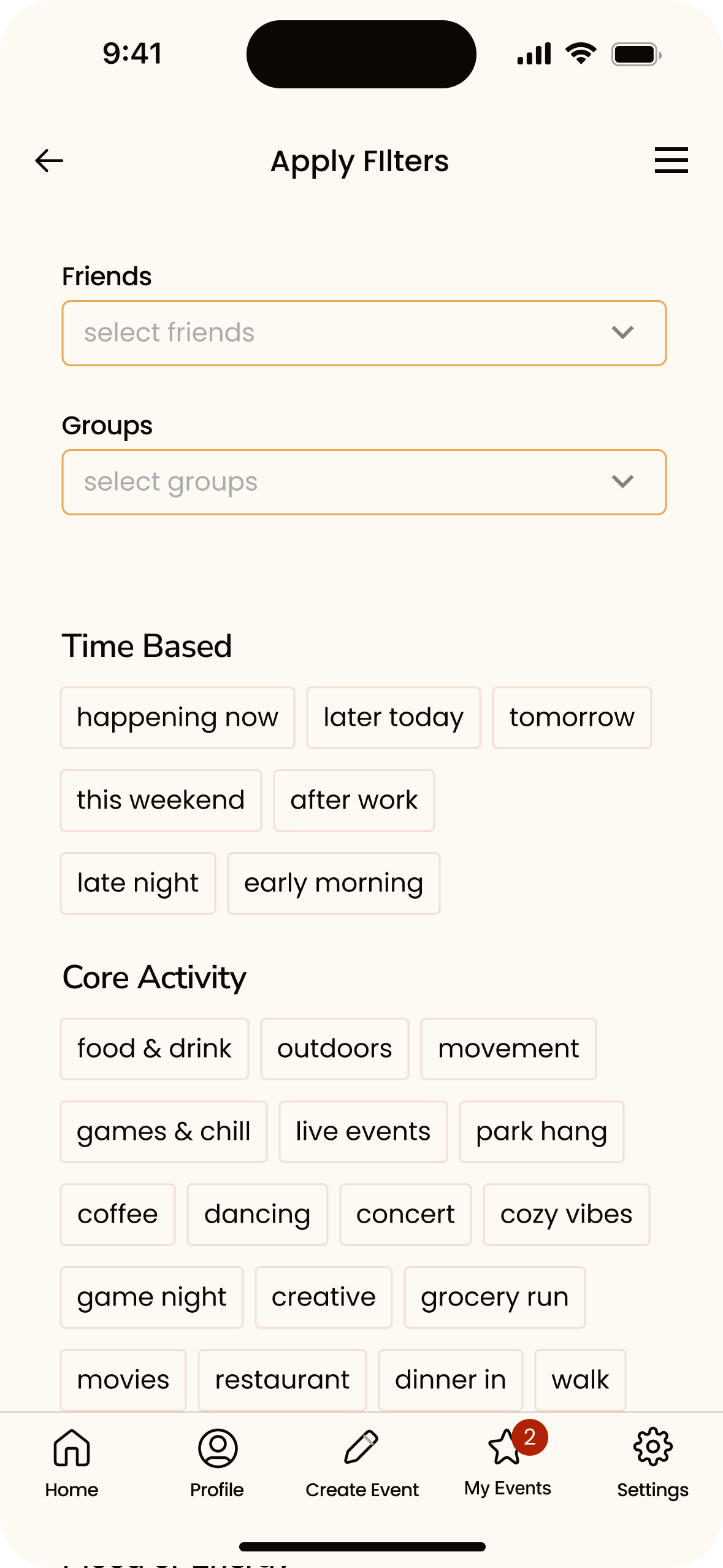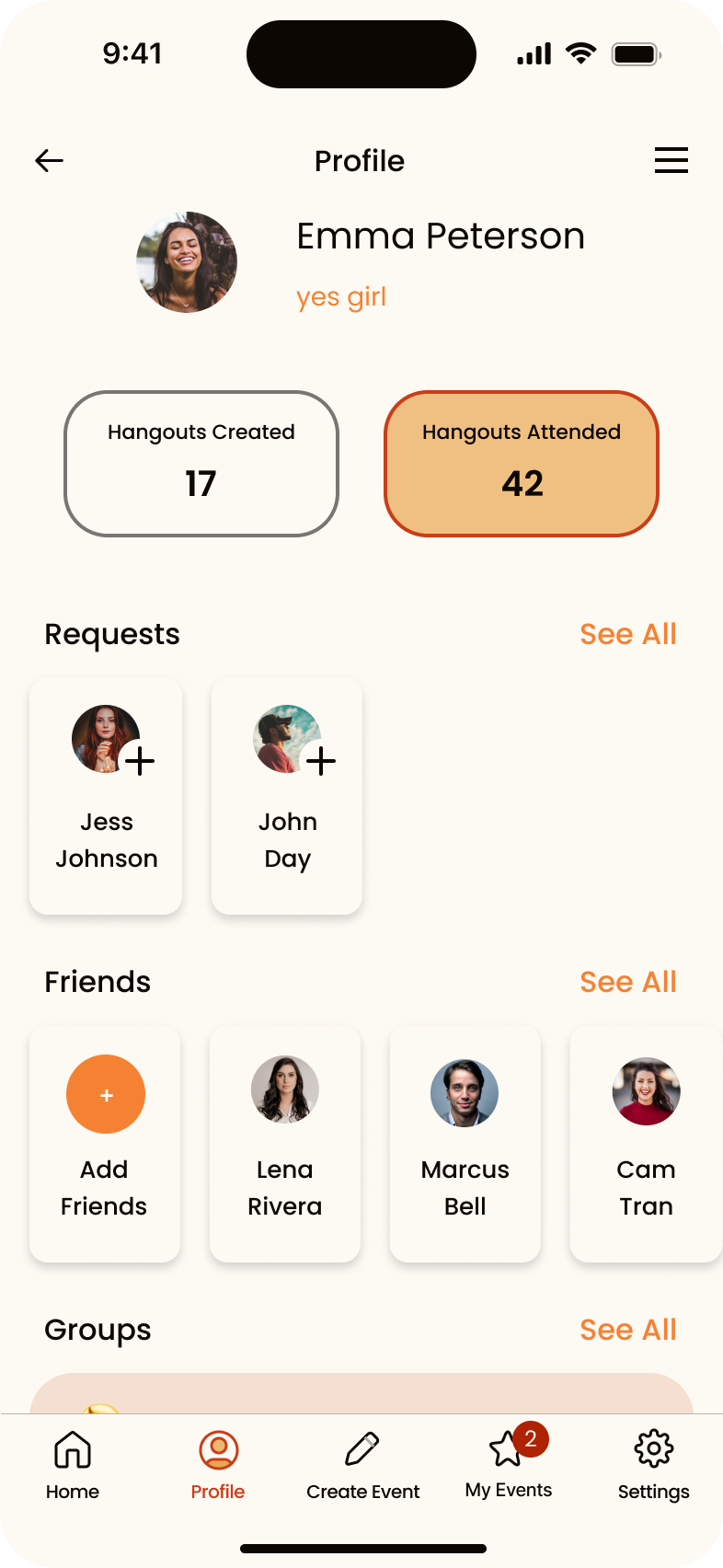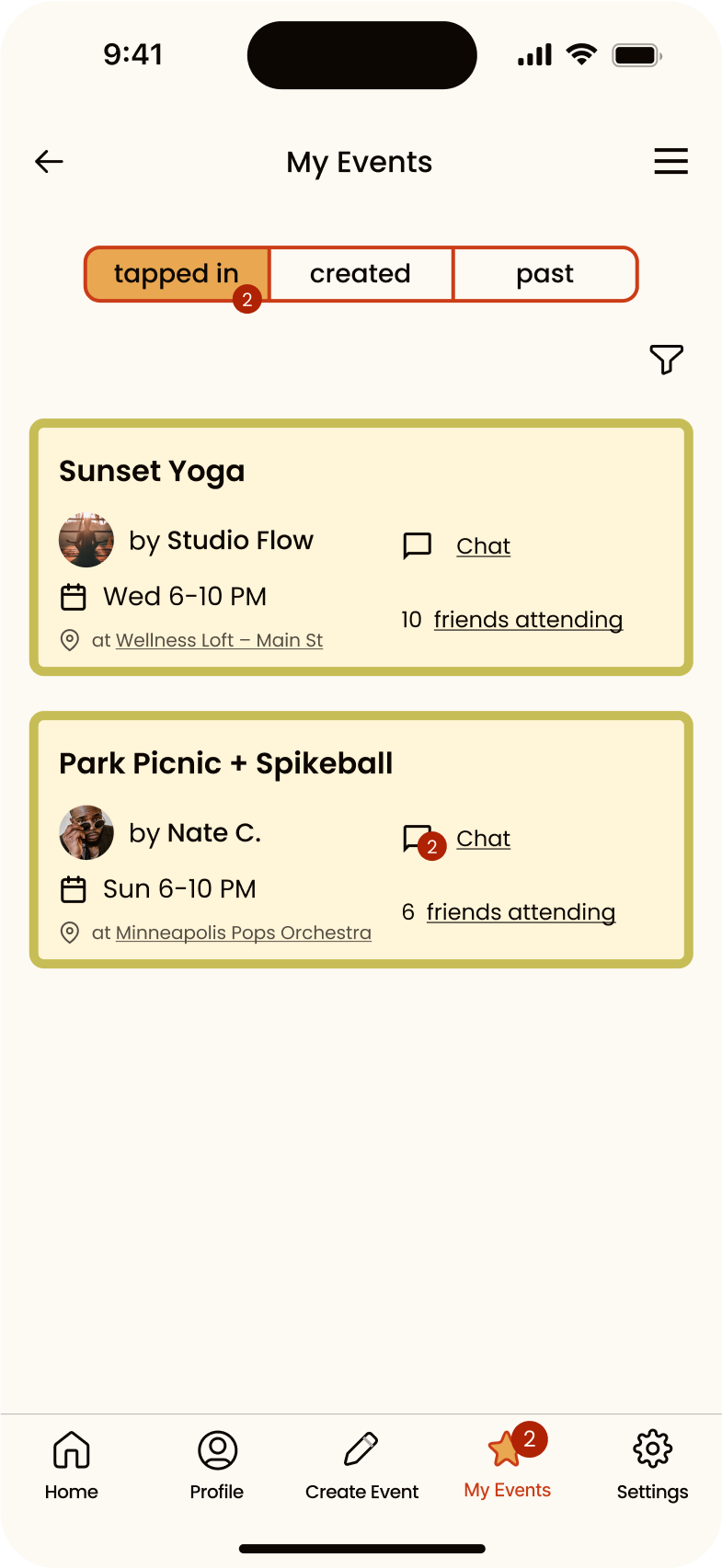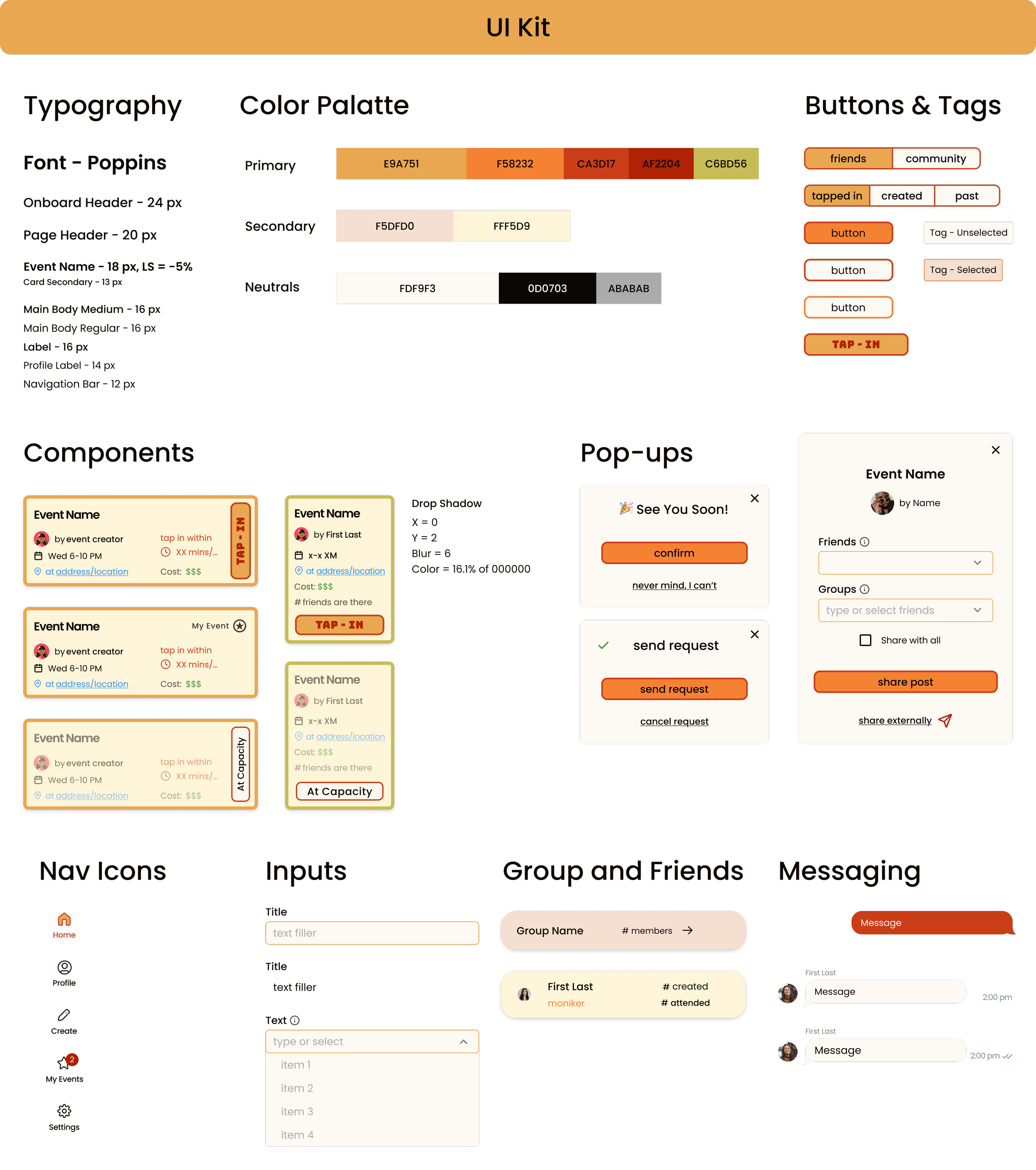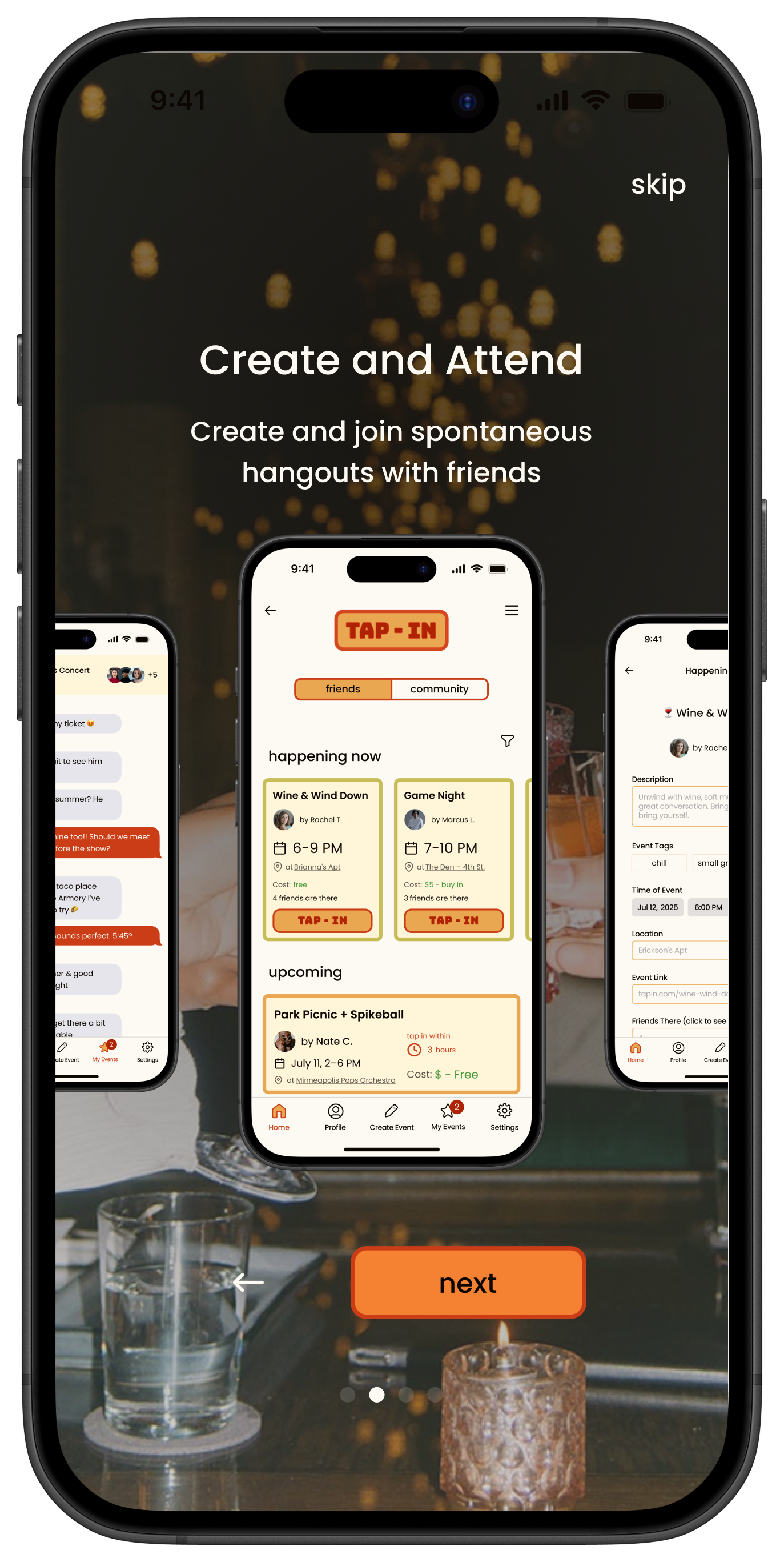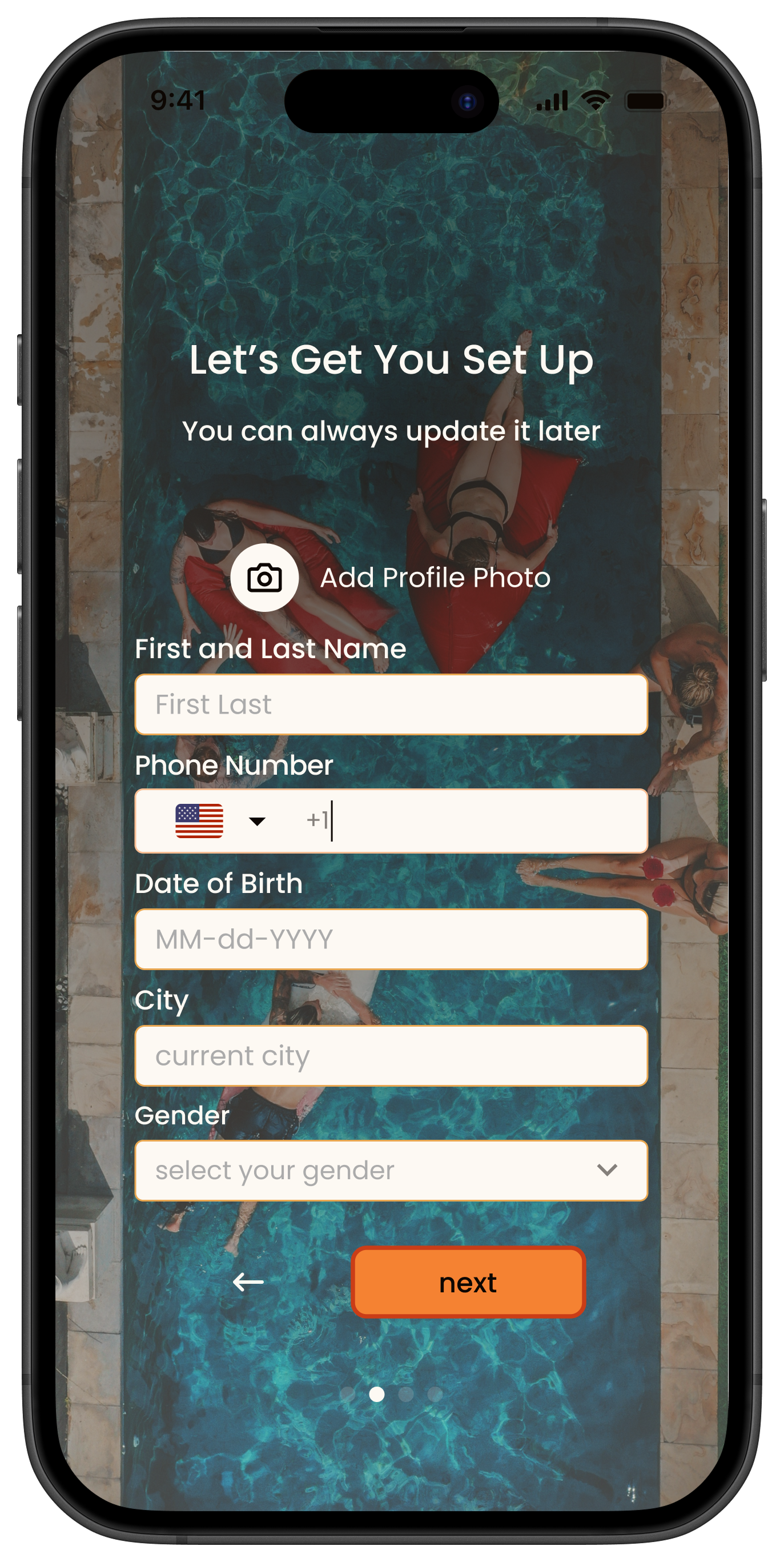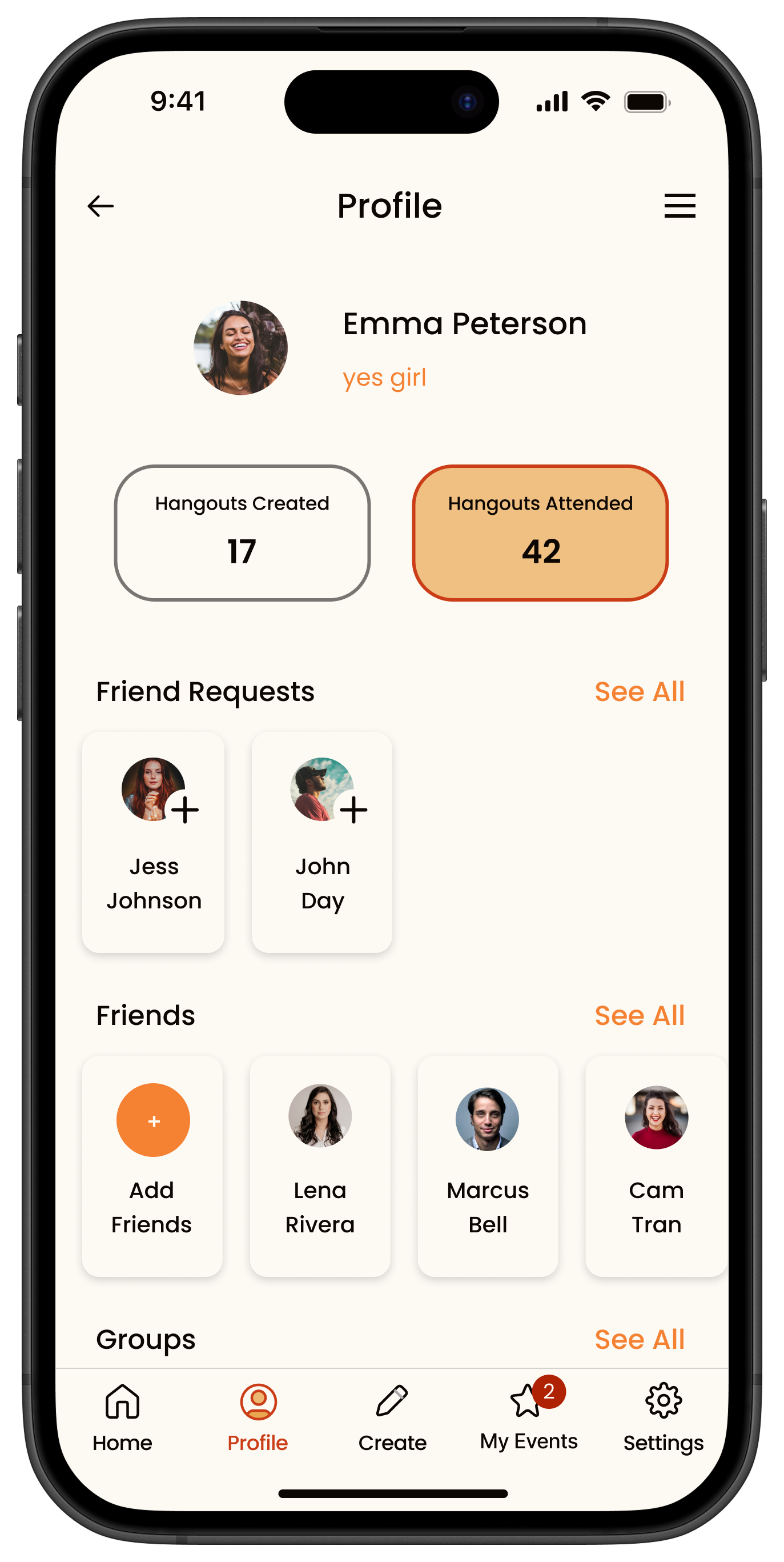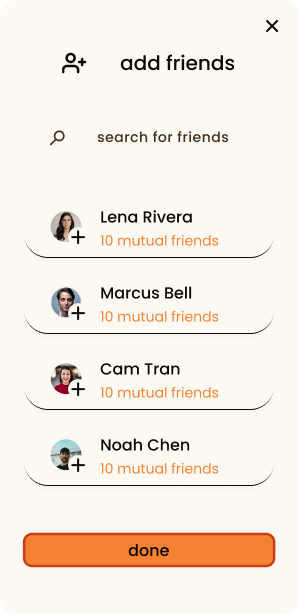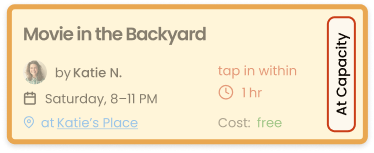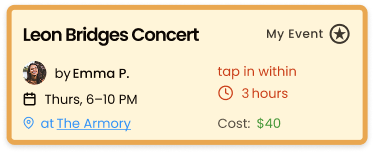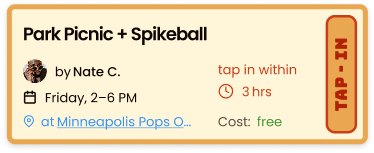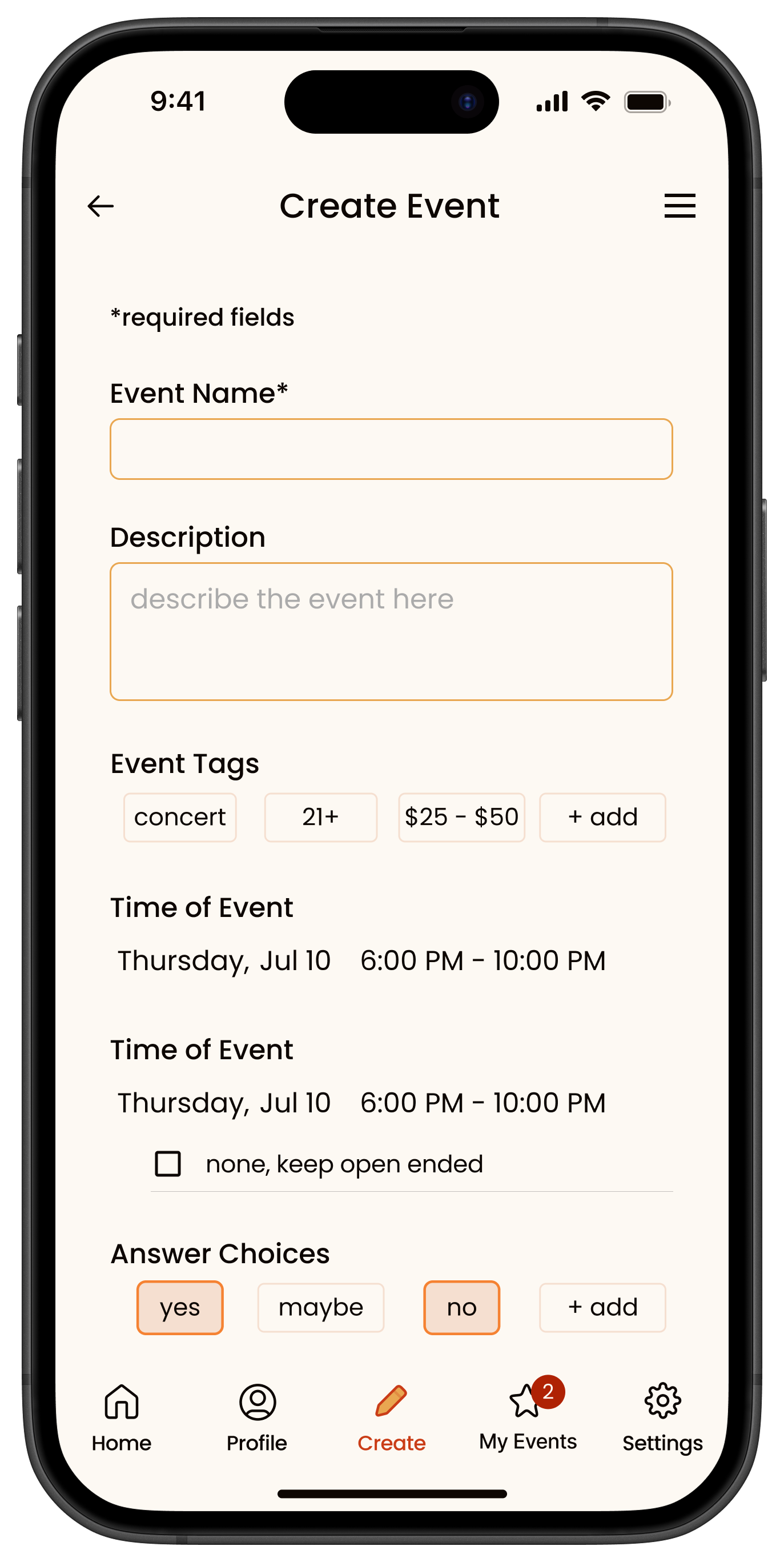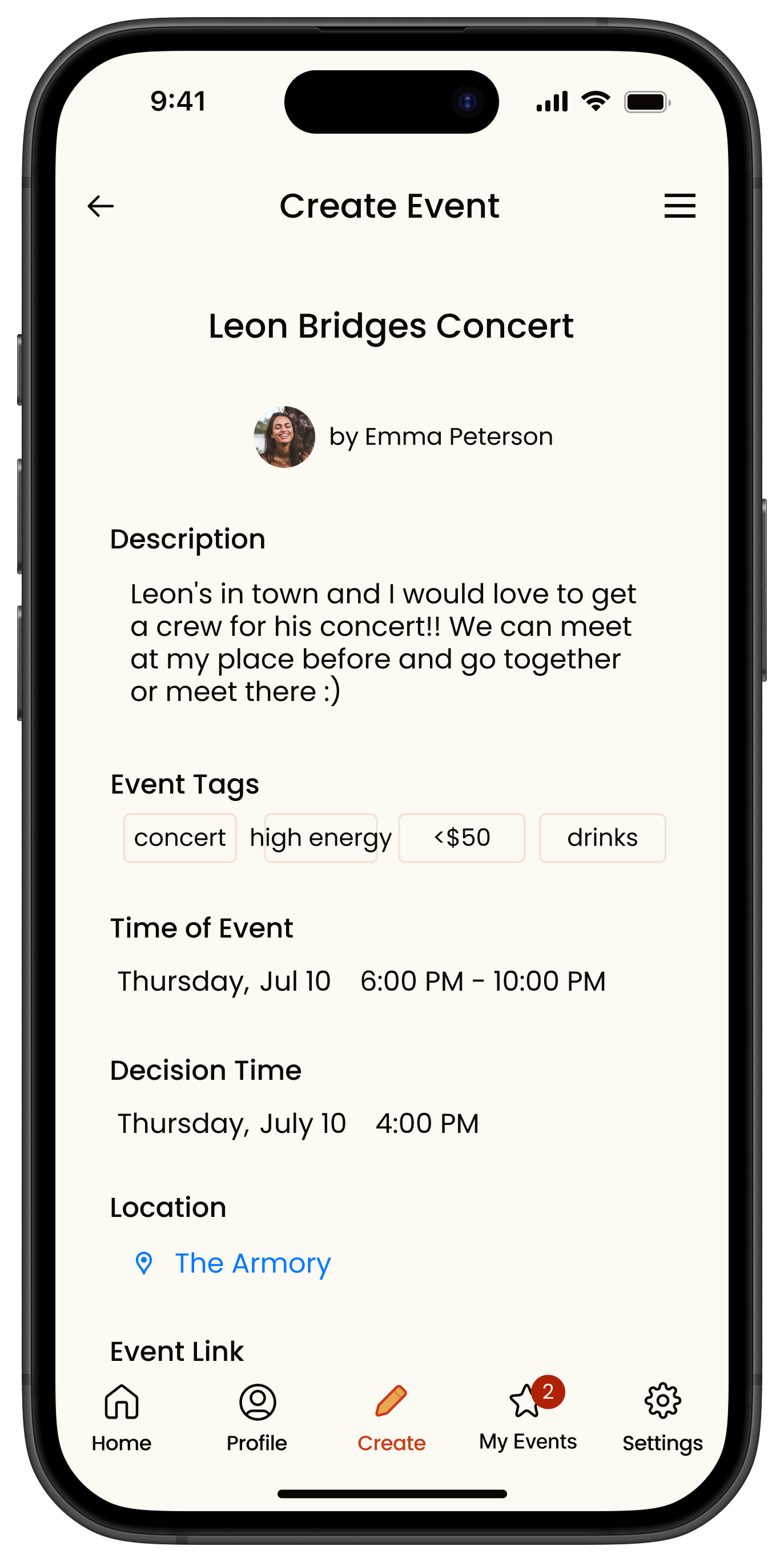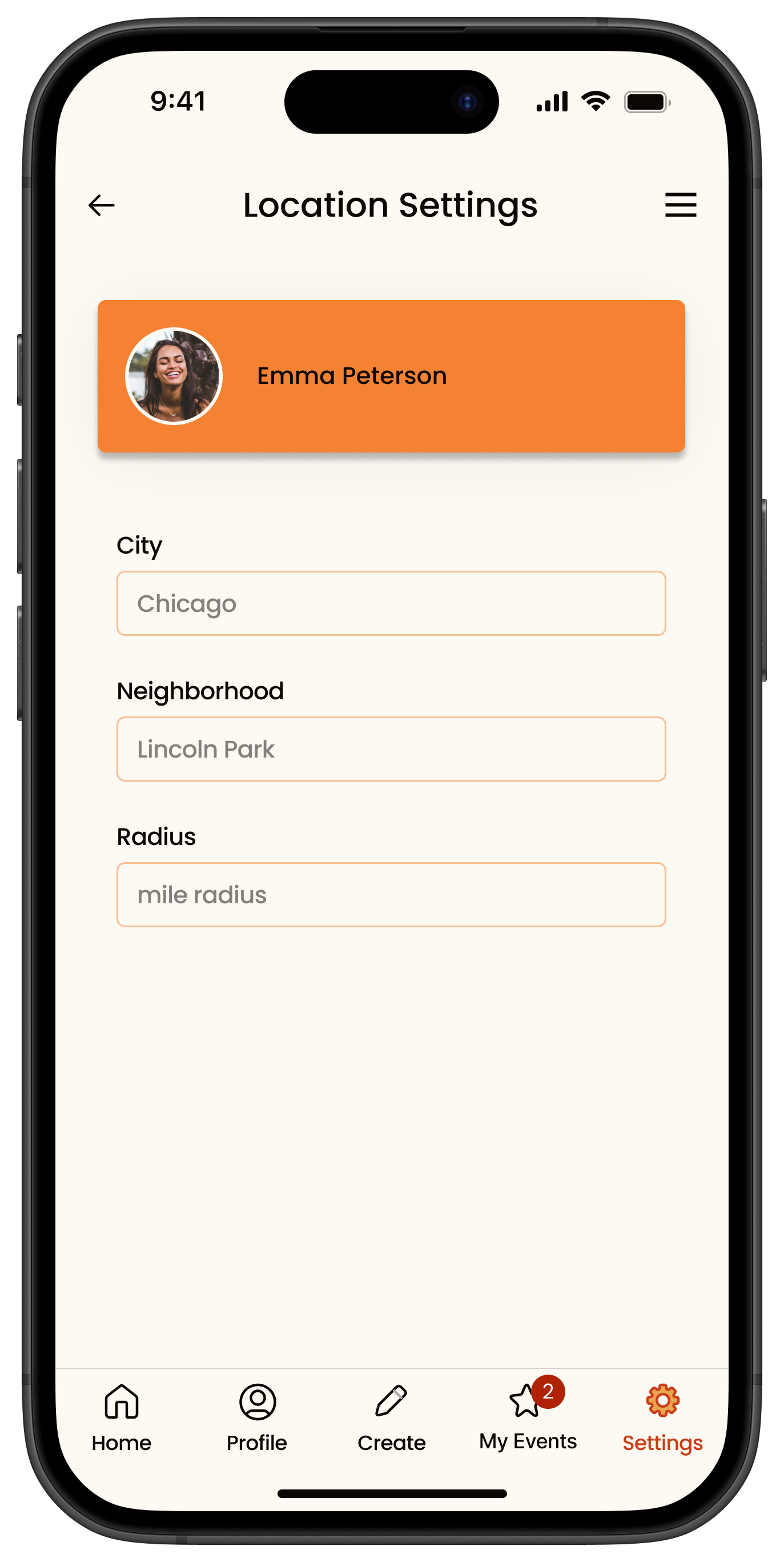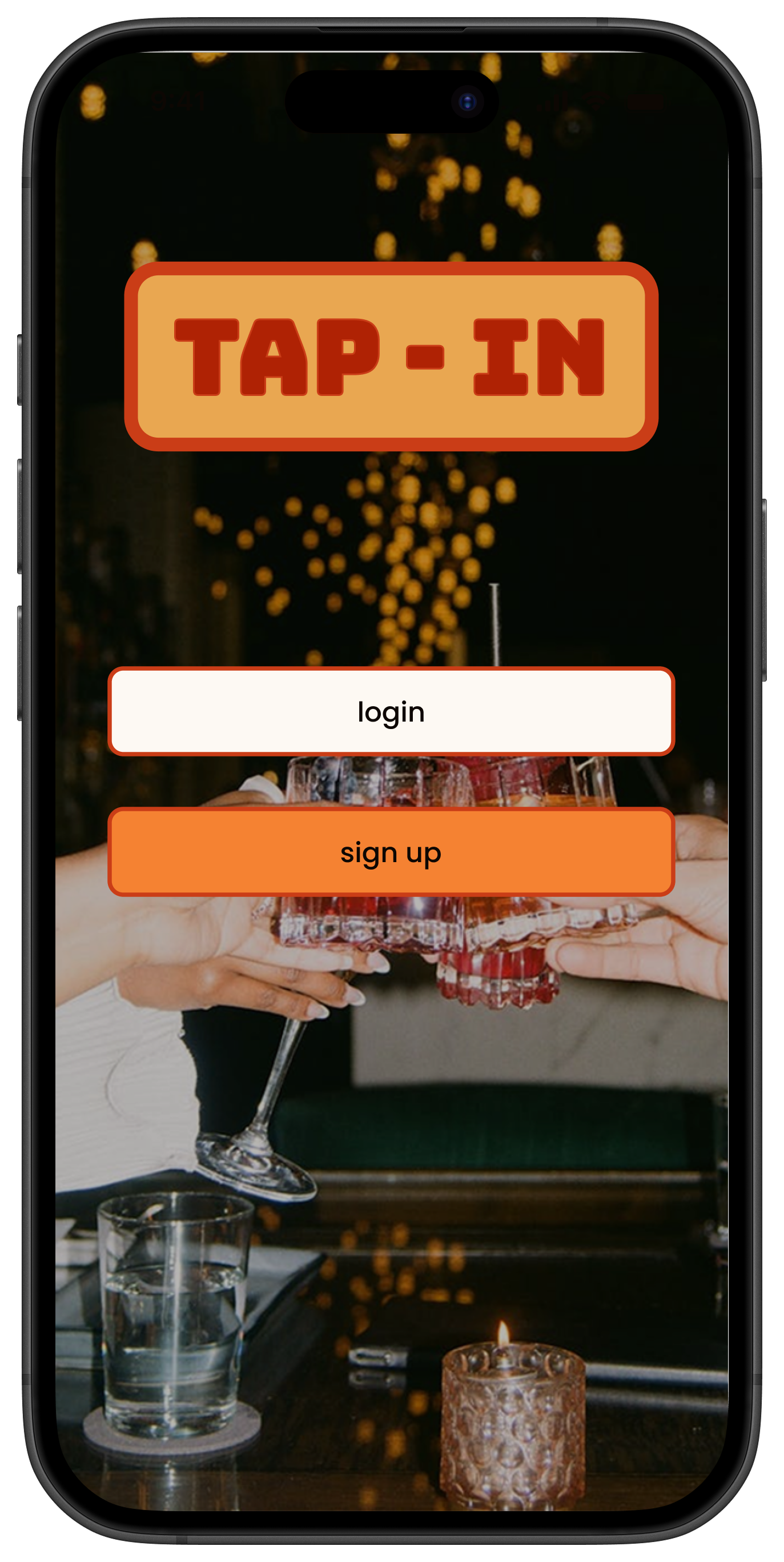Tap in - hangout app
connect with friends through low stakes spontaneous hangsProject Background
Spontaneous plans can be stressful for young adults due to scheduling conflicts and coordination effort, often unintentionally excluding friends. Tap In simplifies this by letting users casually broadcast availability or browse nearby low-key plans, with lightweight group sharing, real-time visibility, and privacy-aware controls, making spontaneous socializing effortless.
Note: This project was created as a student concept for educational purposes and is not affiliated with any existing platform.
My Role
As sole designer, I led the project from concept to usability testing, including user research, interaction and visual design, interactive prototyping, and usability testing—grounding each decision in user insights to create an intuitive, empathy-driven experience.
Scope
User Research – Identify needs and challenges in posting/joining hangs
UX/UI Design – Design intuitive, accessible interfaces
Branding – Develop cohesive colors, fonts, logo, and visual style
Prototyping – Build interactive prototypes for testing
Usability Testing – Refine experience based on feedback
Timeline
📅 4 months → April–July 2025
⏱️ 15 hrs/week (part-time)
Table of Contents
Table of Contents
Introduction
Introduction
Problem
Young adults want casual hangouts but face friction with spontaneous planning. Existing platforms focus on structured events or group chats, making it hard to see availability or share informal plans. This leads to missed connections and feelings of isolation.
Solution
Tap In reduces this friction with a lightweight, availability-based feed. Users can post casual plans in a few taps, browse nearby hangouts, and selectively share with friend groups—without RSVP pressure or formal event structures. By replacing group texts with a flexible social feed, the app makes spontaneous connection simple, fun, and privacy-aware.
Background Research
Background Research
Even years after lockdowns ended, many older adults haven’t returned to their pre-pandemic routines. CU Boulder researchers say these changes could ripple through health and community life for years to come.
“Years after the U.S. began to slowly emerge from mandatory COVID-19 lockdowns, more than half of older adults still spend more time at home, and less time socializing in public spaces than they did pre-pandemic, according to new CU Boulder research.”
“We found that the pandemic fundamentally altered neighborhoods, communities and everyday routines among aging Americans, and these changes have long-term consequences for their physical, mental, social and cognitive health,” said Finlay.
“Still, Finlay worries that the loss of spontaneous interactions in what sociologists call “third places” could have serious health consequences.”
Studies show 20% of users create 80% of hangouts (Pareto Principle). Despite two decades of hangout app development, founders consistently face three key barriers: forgetfulness, psychological hurdles, and inconvenient outreach.
“20% of users will create 80% of the hangouts (Pareto Principle).”
“Founders have been building hangout apps for the last 20 years, and we’ve failed every single time, except for once.”
“- these three problems with reaching out: forgetfulness, psychological barriers, and inconvenience.”
Competitor Analysis
I analyzed several existing hangout apps to identify strengths, weaknesses, and opportunities to differentiate
Emit: Spontaneous Hangouts 12+
Target: College-aged users
Features: Suggested activity prompts, friend group segmentation, feed-style event display
Insights: Prompts help overcome indecision; friend groups improve privacy control; playful UI influences perceived polish and credibility.
PAX - Spontaneous hangouts 17+
Target: Young adults seeking casual plans
Features: In-app chat, spontaneous event browsing, filters by cost/time/location
Insights: Quick chat supports coordination but must preserve spontaneity; filters improve relevance but can lead to over-planning; local event surfacing boosts utility.
Circle: Meetups with friends
Target: General friend groups planning small gatherings
Features: Location-based discovery, real-time updates, polls for group decisions
Insights: Geofencing aids practicality; polls can slow decision-making; live chat keeps groups aligned for last-minute meetups.
Partiful
Target: Users planning social events across platforms
Features: Multi-platform invite sharing, event templates, guest tools (RSVP, payments)
Insights: Platform-agnostic sharing increases reach; branding features add fun and personality; app leans toward formal planning, less suited for spontaneous hangs.
Opportunity Areas for Tap In
Low-Effort Social Broadcasting
→ Competitors still focus on structured event planning. Tap In can stand out by letting users casually broadcast availability or vibes without commitment.Selective Sharing by Default
→ While some apps support group targeting, Tap In can make friend-group filtering a core feature, ensuring users never feel they’re broadcasting to everyone.Lightweight Coordination Without Commitment
→ Unlike chat-heavy apps, Tap In can emphasize non-verbal coordination (reactions, interest buttons, casual RSVPs) to reduce social pressure and keep things fun.Design for Vibe Over Structure
→ Instead of planned parties, Tap In can focus on spontaneous, relaxed hangouts like “walk?” or “porch beers?” — prioritizing social energy over event formality.Spontaneity-First Discovery Feed
→ Tap In could combine user-generated availability posts with ambient context (weather, time of day) to surface the right kind of hangouts at the right moment.Polished Yet Playful Aesthetic
→ Tap In can fill the gap between playful but less polished interfaces and overly formal ones, delivering a refined yet approachable look that appeals to older Gen Z and millennials.
User Research
User Research
User interviews
I conducted 6 remote interviews (ages 20s–30s, 45–60 mins each). Focused on:
Persona-building → Social habits, spontaneity, challenges in planning.
Feature feedback → Reactions to RSVP systems, notifications, and event sharing.
Key Insights:
How participants currently coordinate plans.
Comfort with last-minute hangouts.
Decision factors for joining events.
Affinity Mapping
After the interviews, I synthesized insights into thematic clusters. This process revealed key patterns that shaped design decisions, such as:
Templates for easy posting
Flexible attendance options
Customizable notification settings
The mapping helped prioritize solutions that reduced social friction while preserving the spontaneous, low-pressure vibe users wanted.
Information needs:
Quick, scannable details (time, location, cost, group size).
Hang Preferences:
Low-commitment, flexible activities.
Notification Control:
Overload leads to disengagement.
Event Details:
Successful posts include type, duration, location, accessibility.
Social Patterns:
Current tools create friction in sharing availability.
interview Takeaways
User Motivations & Feature Preferences
Spontaneous Socializing
Users want low-effort, same- or next-day hangouts, favoring casual activities. Invites should feel flexible and pressure-free.
Clear Information Needed Upfront
Activity type, mood tags, time, location, cost, group size, and transportation details upfront.
Privacy & Social Controls
Friend-only vs. public events, attendee limits, resharing controls, customizable decline messages, and restricted friends-of-friends sharing.
Dual Feed Structure
Separate friend-initiated and public/business event feeds; friend hangouts prioritized.
Short-Term Planning Focus
Focus on today/tomorrow plans; chronological sorting for easy browsing, not full calendars.
Quick Access & Notifications
Real-time, location-based alerts with countdown timers; banner-style preferred over emails.
Event-Specific Group Communication
Temporary event-linked group chats with auto-delete, plus options to save photos/memories.
Smart Response Systems
Simple RSVP (Yes/Maybe/No) with optional decline context and polite pre-filled messages; show counts without revealing declines.
Interview Insights
Haylee – The Frequent Casual Socializer
Prefers small groups (3–4) for easy coordination, casual activities (dining, drinks, vintage shopping), and quick access to key event details. Large groups frustrate her.
CHLOE - THE SELECTIVE WEEKEND SOCIALIZER
Curates 2–4 weekly hangouts, mostly weekends. Favors chill weekday activities, small groups, clear notifications, strong privacy, and attendee limits.
ADAM - THE SPONTANEOUS ENTHUSIAST
Enjoys last-minute, low-pressure meetups with minimal notice. Likes casual activities, location-based discovery, timed notifications, and sharing events with friends.
RUTH - THE INFORMATION-DRIVEN PLANNER
Needs full event details, RSVPs, and interest alignment before committing. Uses WhatsApp for last-minute plans but prefers organized event discovery; hesitant to post events due to past low engagement.
ALYSSA - THE RESPONSIVE PARTICIPANT
Responds rather than initiates, attending 1–3 small-group events per week. Open to last-minute invites under $100, values simplicity, flexibility, and enough info to decide quickly.
Persona
TARGET AUDIENCE
Emma, a socially motivated late-20s professional living in the city, represents Tap In’s ideal user. Tech-savvy yet overwhelmed by group chats, she seeks low-pressure, flexible ways to connect with friends without heavy planning.
FEATURE ALIGNMENT
Tap In solves Emma’s pain points by letting her casually broadcast availability, browse nearby hangs, and engage without formal invites or RSVP pressure—eliminating group chat clutter and guilt around declining.
DESIGN CONSIDERATIONS
While centered on Emma, the design reflects feedback from broader users, particularly women seeking spontaneous but comfortable socializing. Features like group filters, low-stakes RSVPs, and optional onboarding balance digital fluency with accessibility for casual users.
Problem Statement
Emma has a hard time connecting with friends because reaching out and making plans has become too complicated. She wants to be able to connect with her friends through more spontaneous and lower-stakes hangouts.
💡 insights
-
⚙️ How Might We’s
How might we make the app intuitive so new users don’t find the learning process intimidating?
How might we create groups so users can control who sees their event?
How might we help introverted users feel comfortable saying yes to plans and contributing?
How might we give users more control over sharing and encourage deeper conversations?
How might we allow users to post to groups without pressure or awkwardness?
🔍 Needs
A display showing hangouts with relevant friends and group context
Private friend groups for targeted invites
Mood tags and hangout types that accommodate different energy levels
Clear guest lists and filters to set social expectations
The ability to control who can reshare the event
-
⚙️ How Might We’s
How might we support small group discovery and suggest mutual connections?
How might we provide group cues or simple ways for users to start plans?
How might we send invites or show friend availability in real time?
How might we encourage quick replies to invitations?
🔍 Needs
A feed filtered by shared interests and availability
Easy-to-use templates for proposing hangouts
Lightweight RSVP tools and live availability status where users can block off unavailable times
Countdown timers or soft deadlines to confirm plans
-
⚙️ How Might We’s
How might we surface relevant local events or casual meetups?
How might we create simple tools to track and confirm plan details?
🔍 Needs
A curated local feed of events and low-effort activities
A clean, structured RSVP system that doesn’t rely on chat
-
⚙️ How Might We’s
How might we create a feed of current events and foster a culture where users feel safe posting?
How might we highlight users with shared events and places as cues for hangouts?
How might we encourage repeat app use and regular engagement?
How might we help new users understand and use the app’s social features through clear onboarding?
🔍 Needs
Privacy and visibility controls for social posts
Smart overlap detection of friends’ activities
Notifications when friends create events
Prompts that inspire users to create their own events
Simple onboarding that highlights both active and passive social tools
-
⚙️ How Might We’s
How might we help users feel comfortable re-engaging with old contacts?
How might we support reconnecting with dormant friendships through gentle prompts?
🔍 Needs
Features that reduce awkwardness and make re-entry feel natural
Subtle prompts encouraging reconnection without pressure
Project Goals
User Goals
Spend more time with friends
Easily maintain connections with friends through different phases of life
Attend more activities in their area
Get outside more often
Minimize planning time for last-minute events
Hang out easily with friends and meet people when visiting different cities
Discover local events, activities, and places
Build meaningful relationships and connections
Maintain privacy and control over personal information
Personalize their social experience based on interests
Shared Goals
Consistently use the app to coordinate and hang out with friends
Feel safe using the app and sharing their location
Meet new people and add them to their network to increase friend connections
Build trust and positive experiences within the community
Facilitate smooth coordination through messaging and planning tools
Create engaging social experiences that bring value to all participants
Business Goals
Increase the number of users on the app
Find ways to monetize the app without user ads or by having businesses pay to join
Expand to different cities
Appeal to all different age groups
Improve user retention and long-term engagement
Collect data to enhance matching algorithms and user experience
Build network effects where more users create more value
Develop partnership opportunities with local businesses and venues
Establish sustainable revenue streams
Initial Prototyping
Initial Prototyping
feature set
Drawing from user interviews and competitive analysis, I created a feature prioritization matrix that balances user value with technical complexity. This roadmap focuses on solving core coordination problems first, with "nice to have" and "delightful" features planned for subsequent releases based on user adoption and feedback.
Priority 1:
Must Haves
Friend vs. Business Feed
Toggle between feed of friend posts and curated local events from businesses.
Messaging Center
Group chat created for each event and then dies along with the event.
Priority 2:
Nice to Have
Archived Events
Let users save old events and their conversations for future reference.
Local Business Pages
Concert Venues or local event planners can create events to be reshared.
Priority 3:
Surprising and delightful
Wrapped / Year in Review
Summary of user's hangouts: top friends, most common activities.
Priority 4:
Can come Later
Personality Metrics
Use behavior to build a profile and recommend future events or people.
Site Map
I developed a comprehensive site map to establish the app's information architecture and core user flows. This foundational step allowed me to map out essential features, prioritize navigation pathways, and ensure all key user needs identified during research were addressed in the app structure.
Low Fidelity
Initial wireframes focused on the core user journey:
Discovering nearby hangouts
Making quick decisions
Coordinating plans with minimal steps
Key design principles:
Simplify posting flow
Surface essential info for fast decision-making
Provide social context without overload
This phase introduced new concepts like “tapping in” and selective friend sharing. Rapid user feedback validated information hierarchy and interaction patterns.
Home Page
Profile Page
Create Event
Event Details
Event Chat
Branding
Branding
Branding and Logo creation
Visual Identity
I developed a warm color palette of yellows, oranges, and greens to evoke approachability and casual connection. This nostalgic scheme balances retro charm with modern usability, creating a comfortable atmosphere for spontaneous social opportunities.
Color System
The colors serve both functional and emotional purposes:
- Green indicates "happening now" events (like a go signal)
- Yellow represents upcoming events (mimicking a stoplight)
- Bright tones evoke happiness and excitement about social plans
- Light butter yellow provides readable backgrounds while brighter colors accent key interactions
Logo Evolution
Initially, I experimented with a horizontal "TAP IN" layout within an hourglass shape for time sensitivity. However, this resembled the clothing brand TapouT. I pivoted to make the logo identical to the primary action button—creating a cohesive experience where the logo becomes the main call-to-action throughout the app.
Design Philosophy
The design prioritizes content over interface elements, letting event photos and user interactions take center stage. The integrated "TAP-IN" button serves simultaneously as brand identifier and functional element, creating seamless connection between brand recognition and user action.
Usability Testing
Usability Testing
Testing insights and revisions
This round of usability testing focused on improving Tap In's clarity, functionality, and overall user experience as it evolved from low-fidelity wireframes to mid-fidelity prototype. I conducted 5 moderated remote sessions (30 minutes each) where participants completed task-based scenarios including navigating the app, creating events, interacting with RSVP features, and using social tools. Testing used a semi-functional prototype with screen sharing to allow participants to navigate key user flows. The goal was to uncover usability pain points, assess visual hierarchy, and improve decision clarity before moving into high-fidelity design.
Key Insights & Feedback Themes
and Revisions Made
1. Event Interaction & RSVP Flow
"Decision Time" Confusion: Users consistently misunderstood the term. Suggestions included "Deadline to Apply," "Registration Ends," or using a countdown or exact timestamp. Placement should be more intuitive—near the RSVP buttons or highlighted as a banner.
RSVP Clarity: "In/Out" terminology caused confusion. Preferred alternatives: “I’m In,” “Not Going,” or “Going/Not Going” (especially for older users). Users also requested the ability to respond “Maybe” or “Decide Later.”
Feedback Confirmation: After RSVP, users want a clear confirmation (“See you soon!” with a checkmark or emoji) and an option to “Add to Calendar.”
Regret Messages: Users liked pre-written regret options (e.g., "Already have plans") with some customization. These should appear after declining, not before.
Users needed a clearer decision point when viewing events.
“Decision Time” was retained on the full event detail page but simplified into a live countdown timer on event cards, making urgency more digestible.
The RSVP buttons—“Tap-In” and “Out”—were maintained for branding consistency, but now trigger a confirmation pop-up to reassure users their choice was saved.
After a user taps out, they are shown optional regret messages and can write their own, reinforcing social accountability without cluttering the primary action.
2. Event Cards & Details
Information Density: Users want clearer, richer event cards showing:
Date & time (with date first)
Cost (if any)
RSVP deadline
Event summary or description (à la Partiful)
Visuals to "set the vibe" (user-chosen background images)
Sharing Features: Confusion between "repost" and "share." Suggested:
“Repost to Feed”
Use standard share icons for external sharing
Allow creators to control sharing permissions and enable +1s
Users wanted easier-to-scan cards with clearer event context.
Event cards were redesigned to prioritize the most important info—event name, time, RSVP deadline, and cost—without overwhelming the screen.
The “Repost” button was clarified to read “Post to Feed”, and “Share externally” was separated into underlined text with a share icon to distinguish functions.
These changes improve both legibility and action clarity across the event feed.
3. Navigation and layout
Homepage & Feed: Users want clearer hierarchy and easier access to upcoming events. Filters like “This Week,” “Next Week,” and “This Month” were requested.
"Create Event" Button: Placement was inconsistent—users suggested it be more visible and tied to a floating button or icon.
Home Icon: Include a clear home/dashboard icon to orient users.
Participants wanted better ways to find relevant events.
The “Upcoming Events” section now features filters so the user can automatically pick dates they are available.
A date filter was added so users can browse by time range (e.g., “Today,” “This Week”).
“Create Event” CTAs were added in more contextual areas to reduce friction and encourage spontaneous hosting.
4. Profile Page & Friends
Event History & Groups: Users expect to see:
Attended and upcoming events
Created events
Archived chats
Popular groups & ability to join/leave them
Friend Management: Desired features include:
Adding/removing friends
Creating groups (e.g., “Runners,” “Foodies”)
Blacklisting/muting friends for notifications
Design Simplicity: Keep layout clean. “See All” pages for past events and friend groups improve clarity.
Testers expected more functionality around their personal and social info.
A new “My Events” page shows:
Events you’ve tapped into
Events you’ve created
Past events you’ve attended
Users can now add friends, create public or private groups, and view group chats within their profile.
A “See All” link was added for both friends and groups to improve content visibility.
Mute options were introduced in Settings to give users more control over who appears in their feed. (This mirrors familiar patterns from other social platforms.)
5. Chat & Notifications
Visibility Issues: Chat function was often hard to find. Suggestions:
Use color indicators, badges, or green dots for active chats
Display unread message counts tied to event names
Central Notification System: Needed to manage chat messages and RSVP alerts across events.
Users had trouble locating and understanding chat functionality.
The chat UI was redesigned for better discoverability and to match brand styling.
Unread message indicators were added to event/group cards to show where active conversation is happening.
To keep communication organized, all messages are now viewable only within the “My Events” tab.
6. Accessibility & Inclusivity
Participants expressed interest in filtering events by more than just date.
Users can now filter events by tags like “21+,” “Kid Friendly,” and more to better match their availability or preferences.
An “Add to Calendar” option was added below the event date, allowing users to sync events with external calendar apps of their choice.
Descriptive Language: Avoid jargon—especially for less tech-savvy users.
Event Details: Include info like age restrictions, child-friendliness, or accessibility.
Calendar Integration: Allow users to sync events to Google/Apple Calendar.
User testing flow
Task Flow
Discovery
The journey begins when a user logs into the homepage and browses the events happening now and upcoming. They decide to look more into the event that their friend Nate is hosting because they love playing Pickleball.
Decision
The user sees more details on the event and sees that they can make it, is excited about all the other friends attending and that it’s free! They Tap-In to the event and get a confirmation pop up.
Interaction
The user joins the event and hops into the chat in order to see if there are any more details or things they should know before heading there. They decide to bring cookies and a board game for post spikeball hanging.
UI Kit
UI Kit
User interface kit
To support consistent and scalable design, I built a comprehensive UI kit that defines Tap In’s visual language and interaction patterns. It acts as a centralized guide for future designers and developers, ensuring every new feature aligns with the overall user experience.
The system includes typography styles, a structured color palette, and detailed component documentation for buttons, inputs, cards, and navigation. I outlined various states such as capacity-full events and interaction feedback, along with message formatting for chat and notifications.
Components are responsive and accessible, designed with proper contrast, spacing, and touch target sizing in mind. The visual system maintains Tap In’s warm and approachable tone, helping the app feel cohesive as it grows.
Design Iteration & Final Testing
Design Iteration & Final Testing
Usability Testing
I conducted 5 moderated usability interviews to validate early design decisions and guide iteration.
Focus areas:
First impressions
Navigation patterns
Feature comprehension
Key findings:
✅ Users praised the casual, spontaneous tone and intuitive interface.
⚠️ Pain points included:
Lack of visual feedback
Confusing social functionality
Onboarding friction
Event interaction clarity
Design updates:
Clarified visual hierarchy
Simplified forms
Improved discoverability of chat + Tap In buttons
Enhanced social context (overlapping profile photos, group tags, ownership badges)
Outcome:
Addressed pain points while reinforcing quick, low-effort social coordination.
"I don't see a ton of difference when I look at, like, pre-tap in to, like, post-tap in."
- Rachel
"I would look at the title first, then the date, then how far away it was from me, and then the location."
- Kirsty
One thing I would put here is the skip option... Because this drives me nuts... I would scan these and I would just add a couple that I would like.”
- Kelsey
🔧 Design Changes & Improvements
To I conducted a second round of usability testing with five participants using the high-fidelity prototype. This round focused on first impressions, navigation clarity, and feature comprehension to confirm the interface matched user expectations.
Users responded positively to the concept and casual tone, but testing revealed several areas needing refinement. Based on these insights, I implemented targeted design changes across six key areas to better align with user needs.
Onboarding & User Info
Updated location input to reflect the user’s current city instead of a full address, making it feel more lightweight and privacy-conscious.
Restructured onboarding to allow users to skip optional steps and enter key information first, reducing early friction.
Event details & social interaction
Increased the visibility and prominence of the group chat, turning it into a clear call-to-action button.
Replaced “Friends Going” with user photos and a "+X more" format, making it feel more social and engaging.
Made addresses, event links, and chat access more visibly tappable, improving discoverability.
Friends, Requests, & Groups
Renamed “Requests” to “Friend Requests” for clearer language.
Enabled quick friend adds through shared groups, making it easier to connect with people in your social circles.
Event management & Visual Feedback
Added badges to events users created for quick identification.
Introduced a state for full events to clearly show when capacity has been reached.
Added a Tap In button to the event cards in the Upcoming Events list to support faster responses without opening each event.
Added a visual for the “Can’t Go” state, providing feedback for users opting out.
Forms & Fields
Improved visual distinction between filled-in vs. incomplete fields, giving users a clearer sense of what’s left to complete.
Simplified information fields by removing unnecessary data and eliminating distracting strokes on input lines for a cleaner layout.
Filters & location settings
Introduced a dedicated Location Settings page, allowing users to filter events by city and distance radius.
Refined filters to better match how users search for events — including filters for unread messages, events hosted by friends, and smarter time-based sorting.
HIgh Fidelity Prototype
HIgh Fidelity Prototype
Interactive Prototype
The high-fidelity prototype incorporates all key updates from the latest round of usability testing, including improvements to navigation, visual hierarchy, event interaction, and social features. D
esigned in Figma, the clickable prototype allows users to simulate the full app experience—from onboarding and browsing events to tapping in and interacting with groups.
This version reflects a polished and functional vision of the app, showcasing how user feedback directly informed design decisions. Click the images or button below to explore the live prototype.
Future Considerations
Future Considerations
As TAP-IN grows, new features can expand its community-building potential and enhance the user experience.
One priority is public groups, where users can join interest-based communities (for example runners, creatives, or gamers). Groups would have moderators to guide event creation, manage engagement, and ensure respectful interactions.
Another opportunity is friend profiles, adding a social layer to the app. With privacy controls, users could see which events friends have “tapped into,” surfacing relevant hangouts through peer discovery. Hosts could set visibility preferences for events as public, semi-public, or private.
Looking ahead, TAP-IN will continue to evolve with its community. Future updates will be shaped by user feedback, behavioral insights, and emerging social patterns, while maintaining the spontaneity and simplicity at its core.
